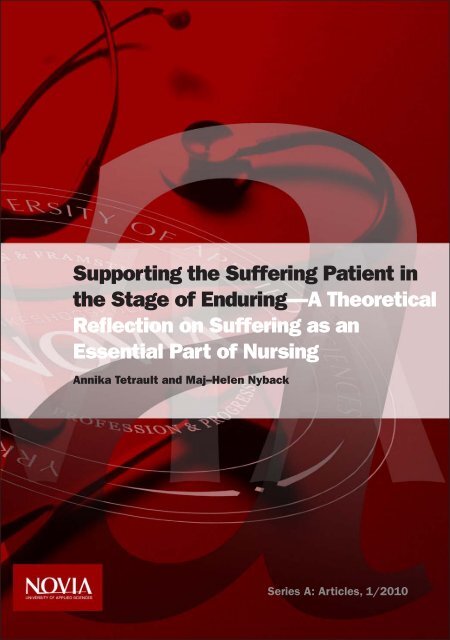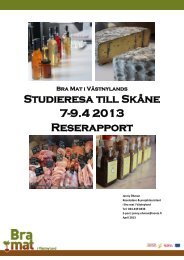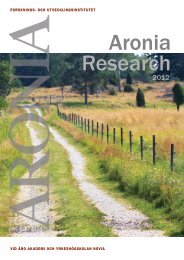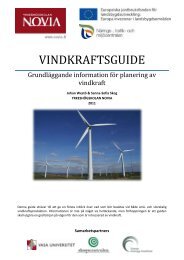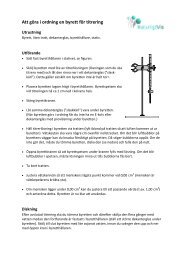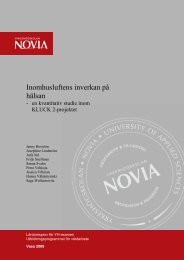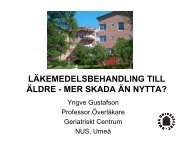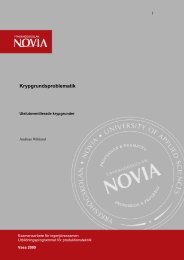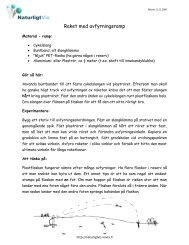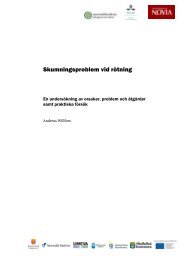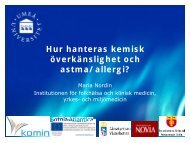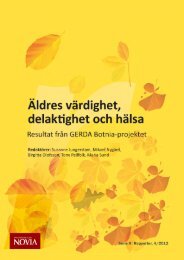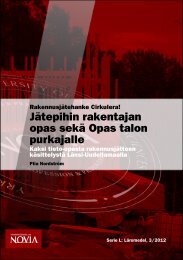Supporting the suffering patient in the stage of enduringâA ...
Supporting the suffering patient in the stage of enduringâA ...
Supporting the suffering patient in the stage of enduringâA ...
You also want an ePaper? Increase the reach of your titles
YUMPU automatically turns print PDFs into web optimized ePapers that Google loves.
<strong>Support<strong>in</strong>g</strong> <strong>the</strong> Suffer<strong>in</strong>g Patient <strong>in</strong><br />
<strong>the</strong> Stage <strong>of</strong> Endur<strong>in</strong>g—A Theoretical<br />
Reflection on Suffer<strong>in</strong>g as an<br />
Essential Part <strong>of</strong> Nurs<strong>in</strong>g<br />
Annika Tetrault and Maj–Helen Nyback<br />
Series A: Articles, 1/2010
www.novia.fi/english
<strong>Support<strong>in</strong>g</strong> <strong>the</strong> <strong>suffer<strong>in</strong>g</strong> <strong>patient</strong> <strong>in</strong> <strong>the</strong> <strong>stage</strong><br />
<strong>of</strong> endur<strong>in</strong>g—A <strong>the</strong>oretical reflection on <strong>suffer<strong>in</strong>g</strong><br />
as an essential part <strong>of</strong> nurs<strong>in</strong>g<br />
Novia Publications and Productions,<br />
series A: Articles, 1/2010
Publisher: Novia University <strong>of</strong> Applied Sciences, Tehtaankatu 1, Vaasa, F<strong>in</strong>land<br />
© 2010 Annika Tetrault, Maj–Helen Nyback,<br />
and Novia University <strong>of</strong> Applied Sciences<br />
Layout: Michael Diedrichs<br />
<strong>Support<strong>in</strong>g</strong> <strong>the</strong> <strong>suffer<strong>in</strong>g</strong> <strong>patient</strong> <strong>in</strong> <strong>the</strong> <strong>stage</strong> <strong>of</strong> endur<strong>in</strong>g—A <strong>the</strong>oretical<br />
reflection on <strong>suffer<strong>in</strong>g</strong> as an essential part <strong>of</strong> nurs<strong>in</strong>g<br />
/ Annika Tetrault, Maj–Helen Nyback.<br />
– Vaasa: Novia University <strong>of</strong> Applied Sciences, 2010.<br />
Novia Publications and Productions, series A: Articles, 1/2010.<br />
2<br />
ISSN: 1799-4187 (Onl<strong>in</strong>e)<br />
ISBN (digital): 978-952-5839-09-8
<strong>Support<strong>in</strong>g</strong> <strong>the</strong> <strong>suffer<strong>in</strong>g</strong> <strong>patient</strong> <strong>in</strong> <strong>the</strong> <strong>stage</strong><br />
<strong>of</strong> endur<strong>in</strong>g—A <strong>the</strong>oretical reflection on <strong>suffer<strong>in</strong>g</strong><br />
as an essential part <strong>of</strong> nurs<strong>in</strong>g<br />
Annika Tetrault and Maj–Helen Nyback<br />
3
Content<br />
Abstract 5<br />
Introduction 5<br />
The concept <strong>of</strong> <strong>suffer<strong>in</strong>g</strong> 6<br />
The concept <strong>of</strong> endur<strong>in</strong>g 7<br />
Types <strong>of</strong> Endur<strong>in</strong>g 8<br />
Discussion 9<br />
References 11<br />
4
SUPPORTING THE SUFFERING PATIENT IN THE STAGE OF ENDURING<br />
—A THEORETICAL REFLECTION ON SUFFERING AS<br />
AN ESSENTIAL PART OF NURSING<br />
Abstract<br />
Nurs<strong>in</strong>g and car<strong>in</strong>g sciences are relatively new sciences. Nurs<strong>in</strong>g and car<strong>in</strong>g<br />
for sick people have been part <strong>of</strong> human history s<strong>in</strong>ce <strong>the</strong> beg<strong>in</strong>n<strong>in</strong>g <strong>of</strong> time,<br />
but it was not until <strong>the</strong> mid 1950s that nurs<strong>in</strong>g was seen as a science <strong>of</strong> its<br />
own. Theories describ<strong>in</strong>g nurs<strong>in</strong>g and car<strong>in</strong>g have been published s<strong>in</strong>ce<br />
<strong>the</strong> 1950s. In <strong>the</strong>se <strong>the</strong>ories, different concepts <strong>in</strong> <strong>the</strong> metaparadigm <strong>of</strong><br />
nurs<strong>in</strong>g are described. The overall aim <strong>of</strong> this essay is to describe <strong>suffer<strong>in</strong>g</strong><br />
as one <strong>of</strong> <strong>the</strong> build<strong>in</strong>g blocks <strong>of</strong> <strong>the</strong> metaparadigm <strong>of</strong> nurs<strong>in</strong>g; fur<strong>the</strong>rmore<br />
<strong>the</strong> essay discusses <strong>the</strong> concept <strong>of</strong> endur<strong>in</strong>g related to <strong>suffer<strong>in</strong>g</strong> and how<br />
<strong>the</strong> caregiver can support a <strong>patient</strong> <strong>in</strong> <strong>the</strong> <strong>stage</strong> <strong>of</strong> endur<strong>in</strong>g <strong>suffer<strong>in</strong>g</strong>.<br />
Introduction<br />
Nurs<strong>in</strong>g and car<strong>in</strong>g are <strong>in</strong>creas<strong>in</strong>gly seen as two separate sciences yet <strong>the</strong>y are<br />
<strong>in</strong>terlocked. While nurs<strong>in</strong>g science focuses on nurs<strong>in</strong>g and its pr<strong>of</strong>ession, car<strong>in</strong>g science<br />
focuses on <strong>the</strong> human car<strong>in</strong>g process, human science orientation, phenomena and<br />
experiences (Nyback 2008). Early nurs<strong>in</strong>g <strong>the</strong>ories were based on nurses as physician<br />
led caretakers and focused on <strong>the</strong> nurs<strong>in</strong>g pr<strong>of</strong>ession. Later nurs<strong>in</strong>g models focus<strong>in</strong>g<br />
on issues related to how and why nurs<strong>in</strong>g actions were taken were developed (Tomey<br />
& Alligood 2006). The discussion <strong>of</strong> a metaparadigm <strong>in</strong> nurs<strong>in</strong>g was <strong>in</strong>itiated by<br />
Fawcett (1995). Powers and Knapp (1990, 87, 103) def<strong>in</strong>e paradigm as “An organiz<strong>in</strong>g<br />
framework that conta<strong>in</strong>s <strong>the</strong> concepts, <strong>the</strong>ories, assumptions, beliefs, values, and<br />
pr<strong>in</strong>ciples that <strong>in</strong>form a discipl<strong>in</strong>e on how to <strong>in</strong>terpret subject matter <strong>of</strong> concern.” They<br />
def<strong>in</strong>e metaparadigm as represent<strong>in</strong>g “<strong>the</strong> worldview <strong>of</strong> a discipl<strong>in</strong>e.” Accord<strong>in</strong>g to<br />
Fawcett (1995, 2005) a metaparadigm has four requirements; a discipl<strong>in</strong>e’s doma<strong>in</strong> has<br />
to be identified and made dist<strong>in</strong>ct, it must conta<strong>in</strong> all phenomena <strong>of</strong> <strong>in</strong>terest, it must<br />
have a neutral perspective and lastly, it must be <strong>in</strong>ternational <strong>in</strong> range and matter.<br />
Concepts are <strong>the</strong> build<strong>in</strong>g blocks <strong>of</strong> <strong>the</strong>ory. The central concepts <strong>in</strong> nurs<strong>in</strong>g<br />
metaparadigm are person, environment, health and nurs<strong>in</strong>g. (Powers & Knapp, 1990,<br />
22, 87, Fawcett 2006). A person is a multidimensional be<strong>in</strong>g consist<strong>in</strong>g <strong>of</strong> physical,<br />
5
ARTICLE<br />
psychological, socio–cultural, developmental and spiritual layers. The person is<br />
<strong>in</strong>teract<strong>in</strong>g with <strong>the</strong> environment, which consists <strong>of</strong> <strong>in</strong>ternal and external forces and<br />
stressors. Health is def<strong>in</strong>es as wellness where <strong>the</strong> person is <strong>in</strong> a dynamic harmony with<br />
all his/her parts. Nurs<strong>in</strong>g is seen as help<strong>in</strong>g <strong>in</strong>dividuals, families and groups to achieve<br />
and ma<strong>in</strong>ta<strong>in</strong> <strong>the</strong> highest level <strong>of</strong> wellness through reduc<strong>in</strong>g stressors. (Neuman 2000).<br />
The concept <strong>of</strong> <strong>suffer<strong>in</strong>g</strong><br />
There have been many attempts at def<strong>in</strong><strong>in</strong>g <strong>the</strong> concept <strong>of</strong> <strong>suffer<strong>in</strong>g</strong>. Eriksson (2006,<br />
22) describes <strong>suffer<strong>in</strong>g</strong> as a struggle between good and evil, as <strong>the</strong> opposite <strong>of</strong> desire.<br />
Cassell (1991) states that “<strong>suffer<strong>in</strong>g</strong> occurs when an impend<strong>in</strong>g destruction <strong>of</strong> <strong>the</strong><br />
person is perceived; it cont<strong>in</strong>ues until <strong>the</strong> threat <strong>of</strong> destruction has passed or until <strong>the</strong><br />
<strong>in</strong>tegrity <strong>of</strong> <strong>the</strong> person can be restored <strong>in</strong> some o<strong>the</strong>r manner.” Wiklund (2000, 90)<br />
sees <strong>suffer<strong>in</strong>g</strong> as a “battle between chaos and control where <strong>the</strong> person is constantly<br />
try<strong>in</strong>g to take control over <strong>the</strong> circumstances without really succeed<strong>in</strong>g.”<br />
6<br />
Figure 1. Morse’s Model <strong>of</strong> Suffer<strong>in</strong>g (2001).
SUPPORTING THE SUFFERING PATIENT IN THE STAGE OF ENDURING<br />
—A THEORETICAL REFLECTION ON SUFFERING AS<br />
AN ESSENTIAL PART OF NURSING<br />
Accord<strong>in</strong>g to Morse (2001, 1) <strong>suffer<strong>in</strong>g</strong> consists <strong>of</strong> two behavioral components:<br />
endur<strong>in</strong>g and <strong>suffer<strong>in</strong>g</strong>. In <strong>the</strong> endur<strong>in</strong>g state <strong>the</strong> emotions are repressed and <strong>in</strong> <strong>the</strong><br />
<strong>suffer<strong>in</strong>g</strong> state <strong>the</strong>y are released. The connection between endur<strong>in</strong>g and <strong>suffer<strong>in</strong>g</strong><br />
shows that persons move from endur<strong>in</strong>g to <strong>suffer<strong>in</strong>g</strong> when <strong>the</strong>y manage to recognize<br />
what <strong>the</strong>y are endur<strong>in</strong>g (Fig. 1). They need to build <strong>the</strong>ir emotional strength before<br />
feel<strong>in</strong>g strong enough to take on <strong>the</strong> emotional turmoil <strong>of</strong> <strong>suffer<strong>in</strong>g</strong>. Individuals move<br />
back and forth between <strong>the</strong> two states as <strong>the</strong>ir strength grows or dim<strong>in</strong>ishes. When <strong>the</strong><br />
sufferer accepts <strong>the</strong> changed reality, <strong>the</strong> <strong>suffer<strong>in</strong>g</strong> can be left beh<strong>in</strong>d and new <strong>in</strong>sights<br />
be acquired. (Morse, 1997, 23).<br />
The concept <strong>of</strong> endur<strong>in</strong>g<br />
Accord<strong>in</strong>g to Morse (2001, 1) “endur<strong>in</strong>g occurs as a response to a threat to <strong>the</strong> <strong>in</strong>tegrity<br />
<strong>of</strong> oneself.” Endur<strong>in</strong>g can be described as <strong>the</strong> suppression <strong>of</strong> emotions. The block<strong>in</strong>g <strong>of</strong><br />
emotions makes it possible for <strong>the</strong> person to get a handle on <strong>the</strong> situation. The keep<strong>in</strong>g<br />
<strong>of</strong> all emotions <strong>in</strong>side does not give relief to <strong>the</strong> person. Endur<strong>in</strong>g can have different<br />
levels <strong>of</strong> severity. When <strong>the</strong> threat is most extreme, <strong>the</strong> person will appear robot–like<br />
and disconnected from life. To be able to keep go<strong>in</strong>g <strong>the</strong> <strong>in</strong>dividual has to concentrate<br />
on <strong>the</strong> present. (Morse, 2001, 6). Accord<strong>in</strong>g to Dewar and Morse (1995, 959) endur<strong>in</strong>g<br />
is a stable condition where <strong>the</strong> person focuses all his/her energy on “hold<strong>in</strong>g on”.<br />
In order to escape from endur<strong>in</strong>g and release bottled–up energy <strong>the</strong> person will<br />
have short emotional eruptions. O<strong>the</strong>r escapes <strong>in</strong>clude distract<strong>in</strong>g behaviors to take <strong>the</strong><br />
m<strong>in</strong>d <strong>of</strong>f <strong>suffer<strong>in</strong>g</strong>, examples are <strong>in</strong>tense physical exercise, do<strong>in</strong>g puzzles, and out–<strong>of</strong>–<br />
control laugh<strong>in</strong>g. (Morse, 2001, 7). If <strong>the</strong> strong feel<strong>in</strong>gs conta<strong>in</strong>ed <strong>in</strong>side are allowed<br />
to emerge and <strong>the</strong> endur<strong>in</strong>g is <strong>in</strong>terrupted <strong>the</strong> outcome is an <strong>in</strong>cident <strong>of</strong> sorrow, deep<br />
depression and anger. (Dewar & Morse, 1995, 959).<br />
Be<strong>in</strong>g terrified and out <strong>of</strong> control is seen as a failure to endure. If a <strong>patient</strong> is<br />
merely terrified a nurse’s gentle and comfort<strong>in</strong>g aid can help <strong>the</strong> <strong>patient</strong> stay <strong>in</strong> control.<br />
If a trauma <strong>patient</strong> is out <strong>of</strong> control, <strong>the</strong> reassurance from nurses will not help. The<br />
<strong>patient</strong> will have to be restra<strong>in</strong>ed and sedated. (Morse, 2001, 9).<br />
7
ARTICLE<br />
Types <strong>of</strong> Endur<strong>in</strong>g<br />
Morse (2001, 7) has identified three types <strong>of</strong> endur<strong>in</strong>g: endur<strong>in</strong>g to survive, endur<strong>in</strong>g<br />
to live and endur<strong>in</strong>g to die. Endur<strong>in</strong>g to survive happens when <strong>the</strong>re is a valid physical<br />
danger. The traumatized <strong>in</strong>dividual concentrates on important body functions such<br />
as breath<strong>in</strong>g <strong>in</strong> order to stay <strong>in</strong> control. This <strong>stage</strong> conserves energy and gives medical<br />
staff a chance to safely care for <strong>the</strong> person.<br />
Endur<strong>in</strong>g to live takes place <strong>in</strong> unbearable situations <strong>in</strong> life. The person<br />
concentrates on gett<strong>in</strong>g through each day one by one until <strong>the</strong> situation has passed.<br />
The person might seem blank and non–responsive. In its deepest form endur<strong>in</strong>g<br />
disengages a person from life, leav<strong>in</strong>g no memory <strong>of</strong> <strong>the</strong> traumatiz<strong>in</strong>g event. (Morse,<br />
2001, 6–7).<br />
Endur<strong>in</strong>g to die occurs when <strong>the</strong> ill person comes to <strong>the</strong> conclusion that <strong>the</strong>ir<br />
death is near. The person starts to withdraw bury<strong>in</strong>g his/her emotions. The ill person<br />
limits his/her social circle and physical environment, liv<strong>in</strong>g moment to moment.<br />
Dur<strong>in</strong>g <strong>the</strong> endur<strong>in</strong>g to die phase <strong>the</strong> ill person and his/her family members and<br />
friends are <strong>of</strong>ten not able to communicate about <strong>the</strong> approach<strong>in</strong>g death. The <strong>in</strong>dividual<br />
<strong>in</strong> <strong>the</strong> endur<strong>in</strong>g to die <strong>stage</strong> has very little energy left. Two separate patterns <strong>of</strong><br />
behavior have been observed: cocoon<strong>in</strong>g and resignation. The person <strong>in</strong> a cocoon<strong>in</strong>g<br />
behavior has accepted his/her death and focuses all energy <strong>in</strong>ternally. The person <strong>in</strong> a<br />
resigned state, however, has not accepted his/her impend<strong>in</strong>g death but is too tired to<br />
keep on liv<strong>in</strong>g. (Olson, Morse, Smith, Mayan and Hammond, 2001, 299–301).<br />
8
SUPPORTING THE SUFFERING PATIENT IN THE STAGE OF ENDURING<br />
—A THEORETICAL REFLECTION ON SUFFERING AS<br />
AN ESSENTIAL PART OF NURSING<br />
Discussion<br />
It is a vital part <strong>of</strong> <strong>the</strong> pr<strong>of</strong>ession and an advanced skill <strong>of</strong> a nurse to be able to<br />
recognize which state <strong>of</strong> <strong>suffer<strong>in</strong>g</strong> a <strong>patient</strong> has entered. The care given should be based<br />
on <strong>the</strong> h<strong>in</strong>ts given by <strong>the</strong> <strong>suffer<strong>in</strong>g</strong> <strong>patient</strong>. Nurses need to recognize and differentiate<br />
between <strong>the</strong> endur<strong>in</strong>g and <strong>the</strong> emotionally releas<strong>in</strong>g states <strong>of</strong> <strong>suffer<strong>in</strong>g</strong>. Patients <strong>in</strong> <strong>the</strong><br />
different <strong>stage</strong>s <strong>of</strong> <strong>suffer<strong>in</strong>g</strong> should be treated accord<strong>in</strong>g to <strong>the</strong> demands <strong>of</strong> each phase.<br />
(Morse, 2001, 14). Accord<strong>in</strong>g to Neuman eller Heyman & Wolfe (2000) a person,<br />
here named <strong>patient</strong>, is <strong>in</strong>teract<strong>in</strong>g with <strong>the</strong> environment. The environment consists<br />
<strong>of</strong> <strong>in</strong>ternal and external stressors. Nurs<strong>in</strong>g is seen as help<strong>in</strong>g <strong>the</strong> <strong>patient</strong> to achieve<br />
and ma<strong>in</strong>ta<strong>in</strong> <strong>the</strong> highest level <strong>of</strong> wellness through reduc<strong>in</strong>g stressors. The situation<br />
that causes <strong>suffer<strong>in</strong>g</strong> as well as <strong>suffer<strong>in</strong>g</strong> itself can be <strong>in</strong>terpreted as stressors to which<br />
a <strong>patient</strong> adapts. Car<strong>in</strong>g for <strong>the</strong> <strong>patient</strong> can be <strong>in</strong>terpreted as help<strong>in</strong>g <strong>the</strong> <strong>patient</strong> to<br />
endure <strong>the</strong> situation.<br />
An experienced pr<strong>of</strong>essional caregiver will have created a procedure <strong>of</strong> how to<br />
approach an endur<strong>in</strong>g <strong>patient</strong>. The distressed <strong>patient</strong> will <strong>in</strong>dicate which approach or<br />
comb<strong>in</strong>ation <strong>of</strong> strategies will be most comfort<strong>in</strong>g at any given time. A <strong>patient</strong> <strong>in</strong> <strong>the</strong><br />
endur<strong>in</strong>g state <strong>of</strong> <strong>suffer<strong>in</strong>g</strong> should be assisted <strong>in</strong> <strong>the</strong> endur<strong>in</strong>g through silent support.<br />
(Morse, 2000, 3). The endur<strong>in</strong>g <strong>patient</strong> should not be “forced” out <strong>of</strong> this state <strong>in</strong>to an<br />
emotional release. It is not necessarily helpful to <strong>the</strong> <strong>patient</strong> to leave <strong>the</strong> endur<strong>in</strong>g state<br />
before <strong>the</strong> time is right. (Morse, 2001, 15).<br />
The state <strong>of</strong> <strong>suffer<strong>in</strong>g</strong> will be clear to <strong>the</strong> pr<strong>of</strong>essional nurse. Behavioral signals<br />
will show which approach to choose. Avoid<strong>in</strong>g physical contact, <strong>of</strong>fer<strong>in</strong>g short<br />
comments on how well <strong>the</strong> <strong>patient</strong> is cop<strong>in</strong>g and silent assistance is appropriate<br />
for <strong>the</strong> endur<strong>in</strong>g <strong>patient</strong>. When <strong>the</strong> <strong>patient</strong> has entered emotional <strong>suffer<strong>in</strong>g</strong> a more<br />
“hands on” strategy is appropriate. Empathy, physical support <strong>in</strong> <strong>the</strong> form <strong>of</strong> touch<strong>in</strong>g<br />
and hugg<strong>in</strong>g, listen<strong>in</strong>g and talk<strong>in</strong>g are strategies that are appropriate <strong>in</strong> this <strong>stage</strong> <strong>of</strong><br />
<strong>suffer<strong>in</strong>g</strong>. (Morse, 2000, 3).<br />
9<br />
In <strong>the</strong> endur<strong>in</strong>g to die <strong>stage</strong> nurses take on a different role <strong>in</strong> support<strong>in</strong>g <strong>the</strong><br />
<strong>patient</strong>. A <strong>patient</strong> who is dy<strong>in</strong>g will <strong>of</strong>ten create anchors to aid <strong>the</strong>m <strong>in</strong> <strong>the</strong>ir fight to
ARTICLE<br />
stay alive. Anchors can be family, friends, and tasks to be f<strong>in</strong>ished or experimental<br />
treatments. A nurse herself can sometimes become an anchor for a <strong>patient</strong> lack<strong>in</strong>g<br />
one. Some nurses experienced <strong>in</strong> palliative care will learn to dist<strong>in</strong>guish between <strong>the</strong><br />
cocoon<strong>in</strong>g and <strong>the</strong> resigned states <strong>of</strong> endur<strong>in</strong>g to die and will be able to comfort <strong>the</strong><br />
<strong>patient</strong> accord<strong>in</strong>gly. The difference <strong>in</strong> <strong>the</strong> treatment <strong>of</strong> resigned versus cocoon<strong>in</strong>g<br />
<strong>patient</strong>s need not be big. The resigned <strong>patient</strong> needs more physical presence even<br />
though nurses might feel difficulty <strong>in</strong> tak<strong>in</strong>g on this anchor<strong>in</strong>g role. (Olson et. al, 2001,<br />
298, 304–306).<br />
Nurs<strong>in</strong>g care science and research are attach<strong>in</strong>g <strong>in</strong>creas<strong>in</strong>g importance to <strong>the</strong><br />
concept <strong>of</strong> <strong>suffer<strong>in</strong>g</strong>. Too much emphasis has been put on <strong>the</strong> aspect <strong>of</strong> “pa<strong>in</strong>” <strong>in</strong><br />
<strong>suffer<strong>in</strong>g</strong>. Not all pa<strong>in</strong> can or should be alleviated. There are different ways <strong>of</strong> help<strong>in</strong>g<br />
a <strong>patient</strong> through <strong>the</strong>ir <strong>suffer<strong>in</strong>g</strong>; pharmaceutical methods are not always appropriate.<br />
A k<strong>in</strong>d gesture, a gentle touch and comfort<strong>in</strong>g words go a long way <strong>in</strong> <strong>the</strong> support <strong>of</strong> a<br />
<strong>suffer<strong>in</strong>g</strong> <strong>patient</strong>. (Morse, 2001, 16).<br />
10
SUPPORTING THE SUFFERING PATIENT IN THE STAGE OF ENDURING<br />
—A THEORETICAL REFLECTION ON SUFFERING AS<br />
AN ESSENTIAL PART OF NURSING<br />
References<br />
Dewar, A & Morse, J. (1995). Unbearable <strong>in</strong>cidents: failure to endure <strong>the</strong> experience <strong>of</strong><br />
illness. Journal <strong>of</strong> Advanced Nurs<strong>in</strong>g 22. 957–964.<br />
Eriksson, K. (2006). The Suffer<strong>in</strong>g Human Be<strong>in</strong>g. Nordic Studies Press. Chicago. 22.<br />
Fawcett, J. (1995). Analysis and evaluation <strong>of</strong> conceptual models <strong>of</strong> nurs<strong>in</strong>g (3rd ed.).<br />
Philadelphia: Davis.<br />
Fawcett, J. (2005) Contemporary nurs<strong>in</strong>g knowledge: analysis and evaluation <strong>of</strong><br />
nurs<strong>in</strong>g models and <strong>the</strong>ories. Philadelphia. Daviscop.<br />
Morse, J. (1997). Respond<strong>in</strong>g to Threats to Integrity <strong>of</strong> Self.<br />
Advances <strong>in</strong> Nurs<strong>in</strong>g Science. June. 21–36.<br />
Morse, J. (2000). Respond<strong>in</strong>g to <strong>the</strong> Cues <strong>of</strong> Suffer<strong>in</strong>g.<br />
Health Care for Women International. 21 (1) 1–9.<br />
Morse, J. (2001). Toward a Praxis Theory <strong>of</strong> Suffer<strong>in</strong>g. Advances <strong>in</strong> Nurs<strong>in</strong>g Science.<br />
24 (1) 1–21.<br />
Neuman Systems Model: Metaparadigm (2000) borde det <strong>in</strong>te vara Heyman,<br />
P. & Wolfe, S 2000?. [Onl<strong>in</strong>e].<br />
http://www.pa<strong>the</strong>yman.com/essays/neuman/metaparadigm.htm<br />
(retrieved 24.11.2009).<br />
Nyback, M–H. (2008) Generic and Pr<strong>of</strong>essional Car<strong>in</strong>g <strong>in</strong> a Ch<strong>in</strong>ese Sett<strong>in</strong>g.<br />
An Ethnographic Study. Doctoral dissertation. Åbo Akademi.<br />
Olson, K. Morse, J. Smith, J. Mayan, M & Hammond, D. (2001).<br />
L<strong>in</strong>k<strong>in</strong>g Trajectories <strong>of</strong> Illness and Dy<strong>in</strong>g. Omega 42 (4) 293–308.<br />
Tomey, A., Alligood, M. (2006) Nurs<strong>in</strong>g <strong>the</strong>orists and <strong>the</strong>ir work. St. Louis, Mosby.<br />
Powers, B. A. & Knapp, T. R. (1990). A Dictionary <strong>of</strong> nurs<strong>in</strong>g <strong>the</strong>ory and research.<br />
Newbury Park: Sage Publications. 22, 87, 103.<br />
11<br />
Wiklund, L. (2000) Lidandet som kamp och drama.<br />
Åbo, F<strong>in</strong>land: Åbo Akademis Forlag. 90.
12<br />
ARTICLE
About Novia<br />
Novia University <strong>of</strong> Applied Sciences <strong>of</strong>fers<br />
multidiscipl<strong>in</strong>ary higher education with a practical orientation,<br />
tra<strong>in</strong><strong>in</strong>g pr<strong>of</strong>essionals for expert and development posts.<br />
There are 34 degree programmes lead<strong>in</strong>g to a Bachelor’s Degree.<br />
Three programmes run entirely <strong>in</strong> English:<br />
Integrated Coastal Zone Management <strong>in</strong> Raseborg,<br />
Nurs<strong>in</strong>g <strong>in</strong> Vaasa and Maritime Management <strong>in</strong> Turku.<br />
With its approximately 3500 students and a staff <strong>of</strong> 390,<br />
Novia is <strong>the</strong> largest Swedish–speak<strong>in</strong>g university <strong>of</strong> applied sciences <strong>in</strong> F<strong>in</strong>land.<br />
Novia has activities <strong>in</strong> seven different locations along <strong>the</strong> west coast.<br />
Novia UAS, Tehtaankatu 1, FI–65100 Vaasa, F<strong>in</strong>land<br />
Phone +358 (0)6 328 5000 (switchboard), fax +358 (0)6 328 5110<br />
Admissions Office, PO Box 6, FI–65201 Vaasa, F<strong>in</strong>land<br />
Phone +358 (0)6 328 5555, fax +358 (0)6 328 5117<br />
admissions@novia.fi<br />
www.novia.fi/english
Lidandet är ett grundmotiv för vård och <strong>in</strong>om vårdvetenskapen har begreppet<br />
def<strong>in</strong>ierats som en kamp mellan det onda och det goda (Eriksson, 2006)<br />
mellan kaos och kontroll (Wiklund, 2000) och som förorsakat av sjukdom,<br />
vård och livet självt (existentiellt lidande) (Eriksson 2006). Morse (2001)<br />
beskriver lidandet som två olika stadier, dels uthärdande dels ett emotionellt<br />
lidande. Artikeln nedan beskriver begreppet lidande och hur vårdaren kan<br />
förhålla sig till och l<strong>in</strong>dra medmänniskans lidande.<br />
ISSN: 1799-4187 (Onl<strong>in</strong>e)<br />
ISBN (digital): 978-952-5839-09-8


